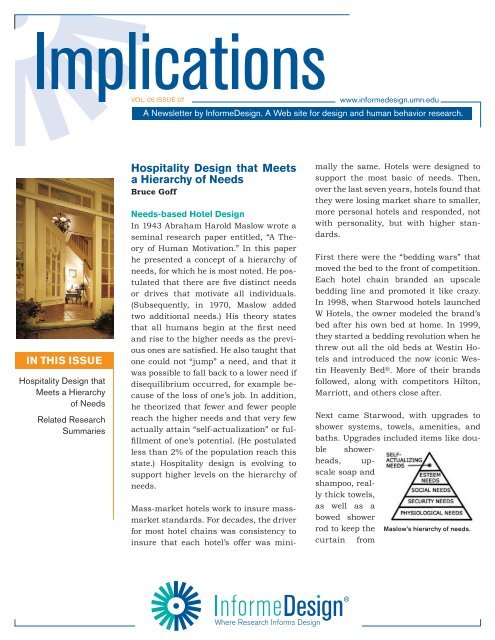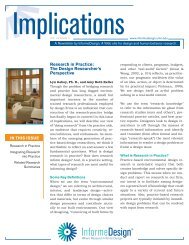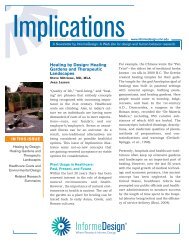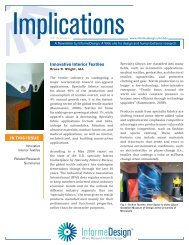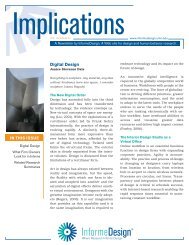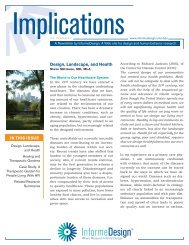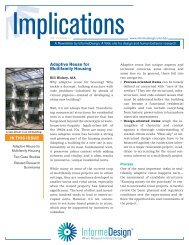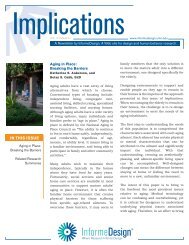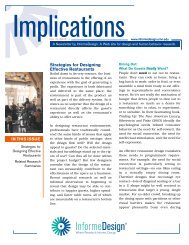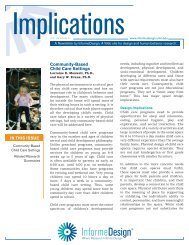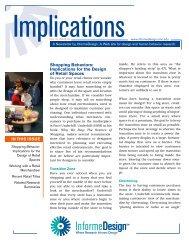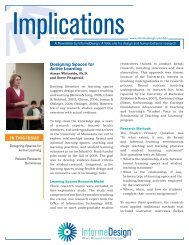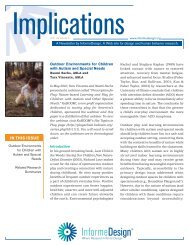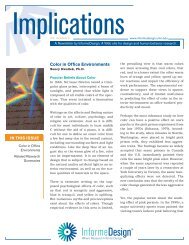Hospitality Design that Meets a Hierarchy of Needs - InformeDesign
Hospitality Design that Meets a Hierarchy of Needs - InformeDesign
Hospitality Design that Meets a Hierarchy of Needs - InformeDesign
Create successful ePaper yourself
Turn your PDF publications into a flip-book with our unique Google optimized e-Paper software.
Implications<br />
VOL. 05 ISSUE 07<br />
cover image<br />
goes here - fit<br />
image to the<br />
black box<br />
using the<br />
guidelines<br />
IN THIS ISSUE<br />
<strong>Hospitality</strong> <strong>Design</strong> <strong>that</strong><br />
<strong>Meets</strong> a <strong>Hierarchy</strong><br />
<strong>of</strong> <strong>Needs</strong><br />
Related Research<br />
Summaries<br />
www.informedesign.umn.edu<br />
A Newsletter by Informe<strong>Design</strong>. A Web site for design and human behavior research.<br />
<strong>Hospitality</strong> <strong>Design</strong> <strong>that</strong> <strong>Meets</strong><br />
a <strong>Hierarchy</strong> <strong>of</strong> <strong>Needs</strong><br />
Bruce G<strong>of</strong>f<br />
<strong>Needs</strong>-based Hotel <strong>Design</strong><br />
In 1943 Abraham Harold Maslow wrote a<br />
seminal research paper entitled, “A Theory<br />
<strong>of</strong> Human Motivation.” In this paper<br />
he presented a concept <strong>of</strong> a hierarchy <strong>of</strong><br />
needs, for which he is most noted. He postulated<br />
<strong>that</strong> there are five distinct needs<br />
or drives <strong>that</strong> motivate all individuals.<br />
(Subsequently, in 1970, Maslow added<br />
two additional needs.) His theory states<br />
<strong>that</strong> all humans begin at the first need<br />
and rise to the higher needs as the previous<br />
ones are satisfied. He also taught <strong>that</strong><br />
one could not “jump” a need, and <strong>that</strong> it<br />
was possible to fall back to a lower need if<br />
disequilibrium occurred, for example because<br />
<strong>of</strong> the loss <strong>of</strong> one’s job. In addition,<br />
he theorized <strong>that</strong> fewer and fewer people<br />
reach the higher needs and <strong>that</strong> very few<br />
actually attain “self-actualization” or fulfillment<br />
<strong>of</strong> one’s potential. (He postulated<br />
less than 2% <strong>of</strong> the population reach this<br />
state.) <strong>Hospitality</strong> design is evolving to<br />
support higher levels on the hierarchy <strong>of</strong><br />
needs.<br />
Mass-market hotels work to insure massmarket<br />
standards. For decades, the driver<br />
for most hotel chains was consistency to<br />
insure <strong>that</strong> each hotel’s <strong>of</strong>fer was mini-<br />
mally the same. Hotels were designed to<br />
support the most basic <strong>of</strong> needs. Then,<br />
over the last seven years, hotels found <strong>that</strong><br />
they were losing market share to smaller,<br />
more personal hotels and responded, not<br />
with personality, but with higher standards.<br />
First there were the “bedding wars” <strong>that</strong><br />
moved the bed to the front <strong>of</strong> competition.<br />
Each hotel chain branded an upscale<br />
bedding line and promoted it like crazy.<br />
In 1998, when Starwood hotels launched<br />
W Hotels, the owner modeled the brand’s<br />
bed after his own bed at home. In 1999,<br />
they started a bedding revolution when he<br />
threw out all the old beds at Westin Hotels<br />
and introduced the now iconic Westin<br />
Heavenly Bed ®. More <strong>of</strong> their brands<br />
followed, along with competitors Hilton,<br />
Marriott, and others close after.<br />
Next came Starwood, with upgrades to<br />
shower systems, towels, amenities, and<br />
baths. Upgrades included items like doubleshowerheads,upscale<br />
soap and<br />
shampoo, really<br />
thick towels,<br />
as well as a<br />
bowed shower<br />
rod to keep the Maslow’s hierarchy <strong>of</strong> needs.<br />
curtain from
Implications www.informedesign.umn.edu<br />
grabbing guests when it billowed. Now we are moving<br />
into the “technology wars”—desktop connections, flat<br />
screens, I-pod docking, even custom alarms. But do<br />
any <strong>of</strong> these connect with the guest?<br />
Satisfied Guests<br />
Many <strong>of</strong> us who travel make decisions on where we<br />
stay based on the most basic needs. Will the hotel be<br />
safe? Will I be comfortable? But can a hotel support<br />
and engage my higher needs? Can a hotel be designed<br />
to support not only the base needs but also needs like<br />
self-esteem and even self–actualization?<br />
One hotel group seems to think <strong>that</strong> it can and must<br />
do so. Chip Conley, CEO <strong>of</strong> Joie de Vivre Hotels, insists<br />
<strong>that</strong> he must make connections with both his<br />
teams and his customers at the level <strong>of</strong> higher needs,<br />
not just supporting them with nice beds and good<br />
showers, but making connections with them. Chip<br />
has a blog <strong>that</strong> describes his strategy for connecting.<br />
“I want to segue into talking about the emotional<br />
connection <strong>that</strong> is created with customers. We are<br />
launching a new Joie de Vivre Hotels website tomorrow<br />
<strong>that</strong>’s pretty revolutionary. It’s all about engaging<br />
in a relationship with our customers. It’s the California<br />
Connect part <strong>of</strong> our site (very Web 2.0) where<br />
people can connect with each other based upon common<br />
interests revolving around the California travel<br />
experience. Check out the cool People Map <strong>that</strong> allows<br />
you to see which people in the JDV online community<br />
are most similar to you and how you can<br />
learn interesting hidden treasures from them. Our<br />
“JDV Gives” portion <strong>of</strong> the site allows you to understand<br />
which specific grassroots non-pr<strong>of</strong>its each <strong>of</strong><br />
our hotels supports (each General Manager has annual<br />
philanthropic giveaway goals just like they<br />
have net income goals). All in all, this website is really<br />
about creating a community around how to experience<br />
California in a way <strong>that</strong> ideally suits who<br />
you are” (http://www.chipconley.com/musings/).<br />
Where Research Informs <strong>Design</strong>®<br />
Petite Theatre Bijou, located in Joie de<br />
Vivre’s Hotel Bijou, San Francisco.<br />
So how is this strategy<br />
supported by design?<br />
Each unique<br />
property is designed<br />
to produce what<br />
Chip calls “identity<br />
refreshment” for his<br />
guests. The company<br />
gleans inspiration<br />
for each hotel from<br />
popular magazines such as Rolling Stone (The Phoenix),<br />
The New Yorker (Hotel Rex), Real Simple meets<br />
Dwell (Vitale), Wired (Avante), and others. Each one is<br />
designed specifically to connect on a higher level with<br />
the guests. No generic designs are here to appeal to a<br />
mass market.<br />
In one hotel <strong>that</strong> is designed to appeal to The New<br />
Yorker crowd, there are extensive literary references in<br />
all aspects <strong>of</strong> furniture and fixtures and even unique<br />
lighting for <strong>that</strong> nighttime read. For the techno-nerd<br />
crowd, one hotel has all the furniture on wheels. Joie<br />
de Vivre’s newest hotel, the Tomo, contains all things<br />
Japanese, but with a decidedly updated feel <strong>of</strong> animation,<br />
as well as the newest pop-culture items <strong>that</strong> are<br />
a must in Japan.<br />
The Joie de Vivre Web site is designed to allow the<br />
guest to find where they belong. It is almost like a<br />
dating site. But in the end it is about belonging: “This<br />
is my hotel and it is a reflection <strong>of</strong> my life.” Each hotel<br />
is designed to impact the guest on a daily basis. Every<br />
item selected for use reflects <strong>that</strong> choice. Just like<br />
a magazine ‘fits’ so do these hotels.<br />
Engaged Employees<br />
Can the interior designer meet the higher needs <strong>of</strong><br />
the staff? Hotel staff in almost every chain have some<br />
guidelines about keeping guests happy; but can the<br />
staff support guests’ higher-level needs, like the need<br />
for esteem? This is where the design can support the<br />
staff. How does the staff interact with the guest at
Implications www.informedesign.umn.edu<br />
check in? Are they still imperiously standing behind<br />
the counter, or does the space allow for a different<br />
sort <strong>of</strong> interaction?<br />
<strong>Design</strong>ers historically focus their most creative work<br />
on the public space <strong>of</strong> a hotel, but leave the non-public<br />
spaces—the back <strong>of</strong> the house—to white paint and<br />
cheap carpet. New ideas need to be considered. In<br />
each facility, is there space for the staff to develop and<br />
engage each other? At a fundamental level, can each<br />
team member do his or her job? It’s <strong>of</strong>ten a fight for<br />
resources and the front <strong>of</strong> the house typically wins,<br />
but it is in the best interest <strong>of</strong> the property as a whole<br />
to move beyond the traditional model <strong>of</strong> neglecting<br />
the support spaces.<br />
The back <strong>of</strong> the house supports the staff <strong>of</strong> this restaurant.<br />
Most hotels can meet the base needs <strong>of</strong> their guests<br />
and staff. The difference is felt when the threshold<br />
<strong>of</strong> friendship, respect, and creativity is crossed. It is<br />
then <strong>that</strong> relationships are forged. The relationship<br />
between employer and employee, staff and guest,<br />
as well as the relationship between a guest and the<br />
property becomes both memorable and important,<br />
creating a full circle. Human nature calls on us to<br />
recreate pleasant, happy experiences. When a full<br />
circle <strong>of</strong> satisfying relationships is realized, employee<br />
Where Research Informs <strong>Design</strong>®<br />
retention becomes less <strong>of</strong> an issue and guest loyalty<br />
skyrockets. It’s when we design the physical space to<br />
nurture the staff <strong>that</strong> we realize this full circle.<br />
Moving from the mindset <strong>of</strong> being “just an employee”<br />
to becoming “part <strong>of</strong> the family,” an employee realizes<br />
his or her position is more than a one-hour orientation<br />
and a day <strong>of</strong> job shadowing. This shift in<br />
thinking produces an environment <strong>that</strong> encourages<br />
each staff member to focus on creating an experience<br />
for the guests, and it provides ongoing recognition <strong>of</strong><br />
<strong>that</strong> effort. By sharing the organization’s vision and<br />
goals and empowering staff to breathe life into the<br />
mission statement, a business moves from being a<br />
place to work, to a network <strong>of</strong> relationships <strong>that</strong> carries<br />
a common value proposition with them during<br />
every human interaction.<br />
Companies can engage their employees in a way <strong>that</strong><br />
makes them feel a deep sense <strong>of</strong> mission and meaning<br />
in what they do. The National Opinion Research Center<br />
at the University <strong>of</strong> Chicago just published a study<br />
in June showing <strong>that</strong> the pr<strong>of</strong>essions with the highest<br />
job satisfaction ratings and general happiness were<br />
those where the employees look at their occupation as<br />
a calling. The top three pr<strong>of</strong>essions were the clergy,<br />
physical therapists, and firefighters. What these pr<strong>of</strong>essions<br />
have in common is a deep sense <strong>of</strong> calling<br />
in what they do every day; they know <strong>that</strong> their “results”—whether<br />
it’s ministering to someone in need,<br />
providing physical therapy to someone who is frail or<br />
injured, or putting out a fire at a family home—make<br />
a big difference to those they are serving.<br />
Self-actualization includes morality, creativity, spontaneity,<br />
problem solving, lack <strong>of</strong> prejudice, and acceptance<br />
<strong>of</strong> facts. It should influence every activity<br />
in the design <strong>of</strong> a hotel for both guests and employees.<br />
<strong>Design</strong>ers strive to create spaces <strong>that</strong> promote<br />
self-actualization; this should show in the designed<br />
environment. If it is embodied in hotel design, then<br />
everyone will benefit.
Implications www.informedesign.umn.edu<br />
Financial Success<br />
Most hotels have unique operation and ownership<br />
structures. Many, if not most, are not owned by the<br />
name <strong>of</strong> the company on the door, but rather by investors.<br />
Unions, insurance companies, and retirement<br />
firms, as well as private individuals, <strong>of</strong>ten hold the<br />
mortage, but hire outside firms to design, construct,<br />
and provide day-to-day management. The inherent<br />
conflict is about how much to spend and on what. Investors<br />
want the quickest and highest return on their<br />
capital, but by considering the needs <strong>of</strong> the staff and<br />
guests, the designer, by default, brings the investors<br />
what they want, a return on their investment.<br />
<strong>Design</strong> for hospitality should no longer be simply considered<br />
only a “wow for the eye,” but a “wow for the<br />
mind.” Using design to engage higher needs supports<br />
the guest, the employee, and the investor. To <strong>that</strong> end,<br />
some advice on hospitality design follows:<br />
• Work with your client to insure <strong>that</strong> attention is<br />
paid to the back <strong>of</strong> the house. This might require<br />
you to educate and/or convince them <strong>of</strong> the importance<br />
<strong>of</strong> investing in this environment.<br />
• Look for opportunities to create lounge areas and<br />
break rooms for staff <strong>that</strong> encourage interaction<br />
and stimulate the exchange <strong>of</strong> ideas.<br />
• Take a look at other businesses <strong>that</strong> are working to<br />
break down barriers; focus on designing collaboraton<br />
and teaming spaces for staff using fewer hard<br />
walls.<br />
• Create opportunities for your guests to connect and<br />
learn what they have in common with each other,<br />
much like the Petite Theatre Bijou inside Joie de<br />
Vivre’s Hotel Bijou. <strong>Design</strong> to create connections<br />
and conversation (see photo, p. 2).<br />
• Analyze every space <strong>that</strong> supports interaction between<br />
staff and guests. You never know where you’ll<br />
find your next great opportunity!<br />
Where Research Informs <strong>Design</strong>®<br />
About the author:<br />
Bruce G<strong>of</strong>f, principal, Domus<br />
<strong>Design</strong> Group, is a licensed interior<br />
designer with over 20 years<br />
in the interior design industry.<br />
In addition to residential design<br />
clients, Domus serves commercial<br />
clients in a wide rage<br />
<strong>of</strong> fields including technology,<br />
hospitality, residential real estate<br />
development, gaming, and telecommunications.<br />
Mr. G<strong>of</strong>f is a member <strong>of</strong> the American Society <strong>of</strong> Interior<br />
<strong>Design</strong>ers, the International Interior <strong>Design</strong> Association,<br />
and the Illuminating Engineers Society. He<br />
is licensed as a registered interior designer in California<br />
and Nevada.<br />
Recommended Resources<br />
—www.chipconnely.com<br />
—www.jdvhotels.com<br />
—www.holisticentrepreneur.net<br />
—www.starwood.com<br />
Related Research Summaries<br />
Informe<strong>Design</strong> has many Research Summaries about<br />
hospitality design and other, pertinent, related topics.<br />
This knowledge will be valuable to you as you<br />
consider your next design solution and is worth sharing<br />
with your clients and collaborators.<br />
“Environmentally-Friendly Hotels in Europe”<br />
—Cornell Hotel and Restaurant Administration<br />
Quarterly<br />
“Hotel and Resort Programs for Children”<br />
—International Journal <strong>of</strong> <strong>Hospitality</strong> & Tourism<br />
Administration
Implications www.informedesign.umn.edu<br />
“Understanding Health Conscious Tourists”<br />
—Journal <strong>of</strong> <strong>Hospitality</strong> and Leisure Marketing<br />
“Music and Job Performance”<br />
—International Journal <strong>of</strong> <strong>Hospitality</strong> and Tourism Administration<br />
“Effects <strong>of</strong> Music on Customers and Employees”<br />
—Journal <strong>of</strong> Retailing and Consumer Services<br />
“Functional and Aesthetic Lighting <strong>Design</strong>”<br />
—Lighting Research and Technology<br />
“Improving Unhealthy <strong>Hospitality</strong> Work<br />
Environments”<br />
—Cornell Hotel and Restaurant Administration<br />
Quarterly<br />
“Experience and Meaning <strong>of</strong> Place”<br />
—Journal <strong>of</strong> Environmental Psychology<br />
“Satisfaction with Cultural and Heritage<br />
Destinations”<br />
—Journal <strong>of</strong> <strong>Hospitality</strong> and Leisure Marketing<br />
“Mood Affects Customer Service”<br />
—Journal <strong>of</strong> Retailing and Consumer Services<br />
“Conserving Water in Hotels”<br />
—International Journal <strong>of</strong> <strong>Hospitality</strong> Management<br />
“Workplace Personalization”<br />
—Environment and Behavior<br />
Creator: Founding Sponsor:<br />
© 2002, 2005 by the Regents <strong>of</strong> the University <strong>of</strong> Minnesota.<br />
“Increase Hotel Pr<strong>of</strong>its Through Planning”<br />
—Cornell Hotel and Restaurant Administration<br />
Quarterly<br />
“<strong>Hospitality</strong> Building <strong>Design</strong> and Materials Impact<br />
Fire Safety”<br />
—International Journal <strong>of</strong> <strong>Hospitality</strong> Management<br />
“Alleviating Mental Fatigue in Urban and Natural<br />
Settings”<br />
—Journal <strong>of</strong> Environmental Psychology<br />
“Sense <strong>of</strong> Place Affects Job Satisfaction and<br />
Motivation”<br />
—Journal <strong>of</strong> Interior <strong>Design</strong><br />
“Accommodating Hotel Employees with Disabilities”<br />
—Cornell Hotel and Restaurant Administration<br />
Quarterly<br />
“Napping and Worker Alertness”<br />
—Ergonomics<br />
Photos courtesy <strong>of</strong>:<br />
http://www.pateo.com/images/maslowmaster4ts.gif,<br />
diagram (p. 1).<br />
Joie de Vivre <strong>Hospitality</strong>, photos (pp. 1-2).<br />
Bruce G<strong>of</strong>f, Domus <strong>Design</strong> Group (remainder).<br />
The Mission<br />
The Mission <strong>of</strong> Informe<strong>Design</strong> is to facilitate designers’<br />
use <strong>of</strong> current, research-based information as a decision-<br />
making tool in the design process, thereby<br />
integrating research and practice.<br />
5


